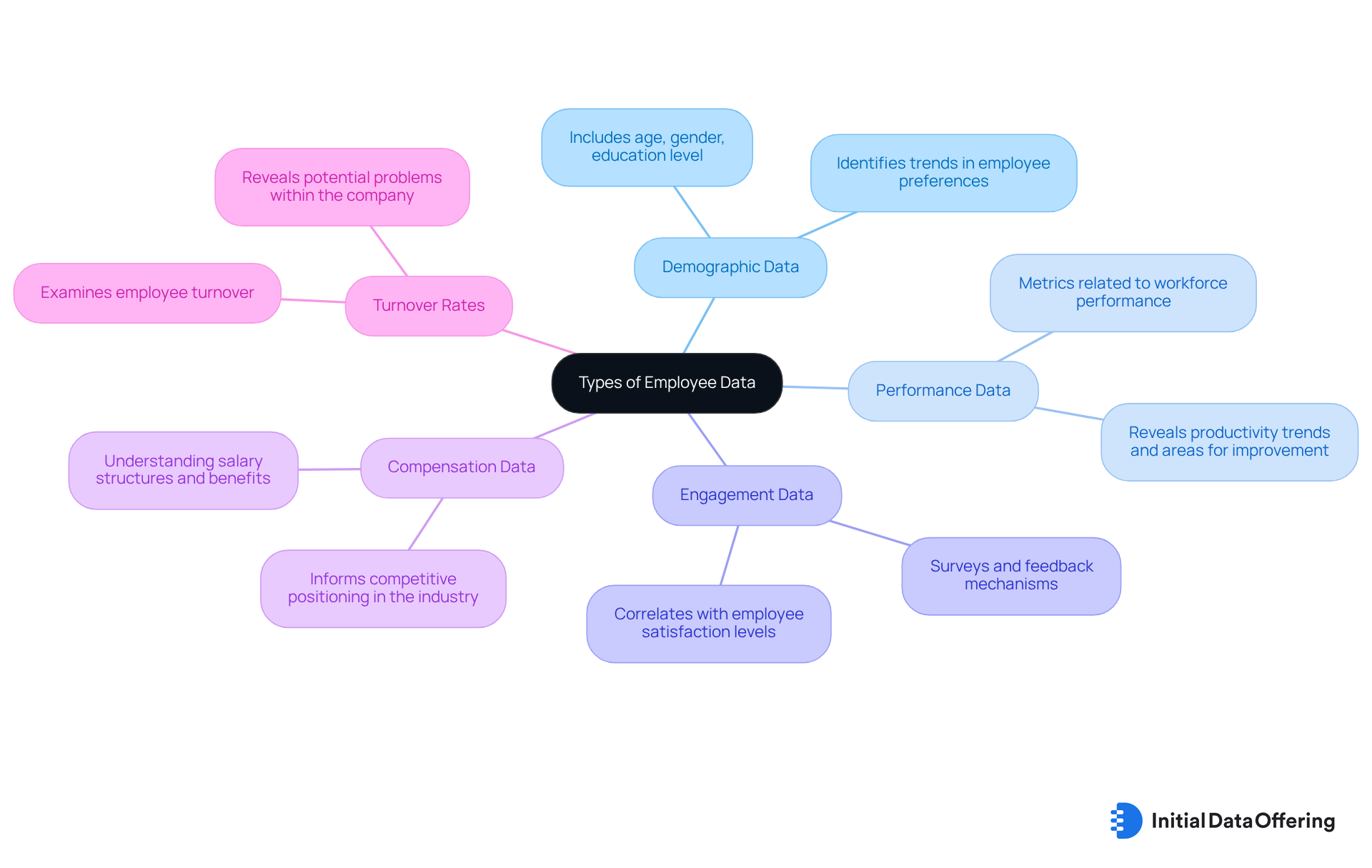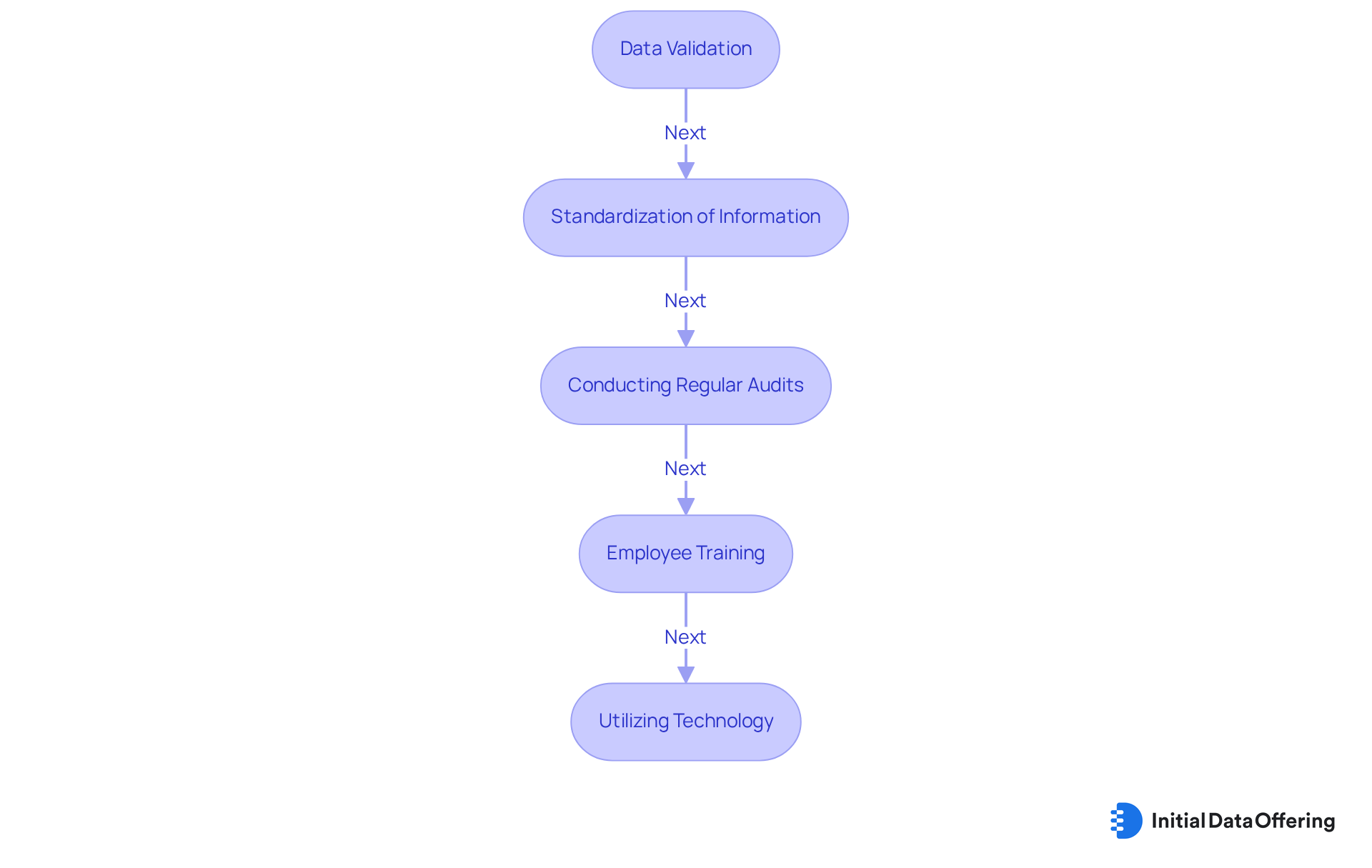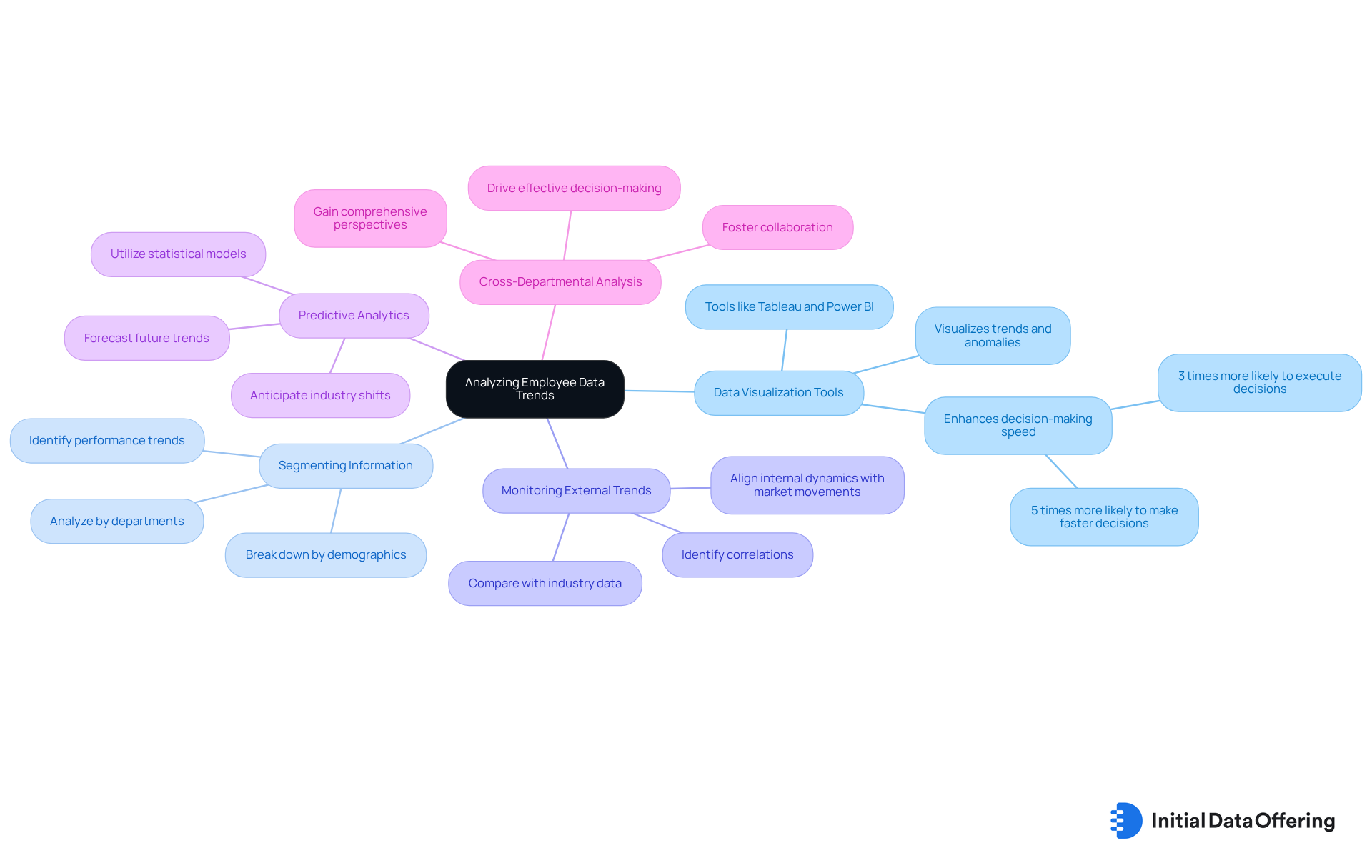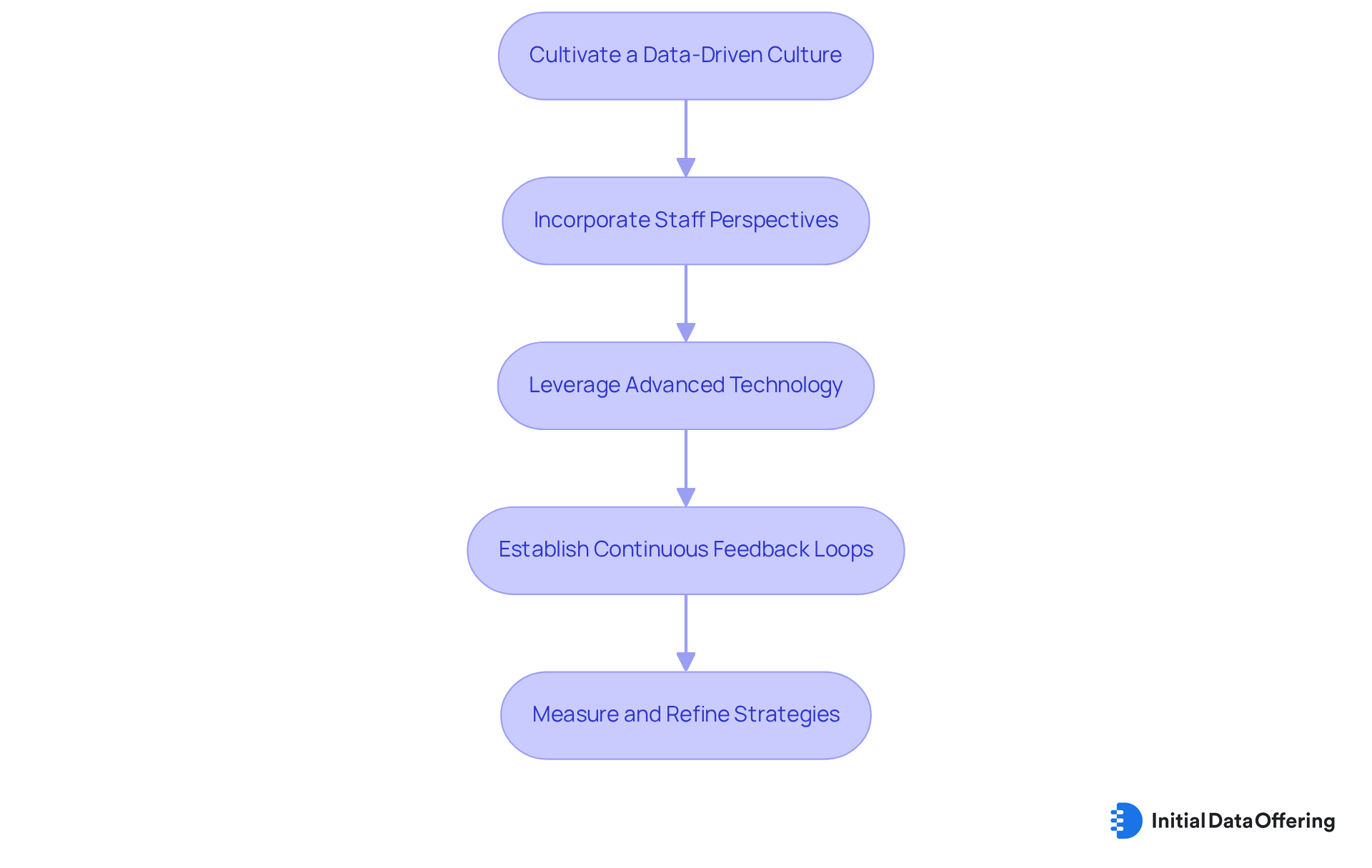5 Strategies to Leverage Employee Data for Market Insights

5 Strategies to Leverage Employee Data for Market Insights
Overview
Organizations can leverage employee data for market insights by analyzing various datasets, including demographic, performance, engagement, compensation, and turnover data. This analysis uncovers trends that inform strategic decisions. By ensuring data accuracy and employing data-driven strategies, companies enhance their market research capabilities. This leads to better alignment with market demands and improved decision-making.
What if organizations could transform their understanding of market dynamics through employee data? By examining these datasets closely, businesses can identify patterns that not only reflect internal performance but also indicate shifts in market expectations. The advantages of this approach are clear: it empowers companies to make informed choices that resonate with both employee needs and market realities.
In conclusion, the effective use of employee data is not just about collection; it's about strategic implementation. Companies that prioritize data accuracy and analysis stand to gain a competitive edge, ultimately fostering a more responsive and agile business environment.
Introduction
In the evolving landscape of business, employee data has become a powerful tool for organizations aiming to secure a competitive edge. By effectively leveraging various types of employee data—such as demographic insights and performance metrics—companies can uncover valuable market insights that drive strategic decision-making.
However, a significant challenge persists: how can organizations ensure the accuracy and relevance of this data to truly capitalize on its potential?
Exploring the intersection of employee data and market research reveals strategies that not only enhance understanding but also foster a data-driven culture. This culture is capable of responding effectively to market demands, ultimately benefiting the organization as a whole.
Understand the Types of Employee Data Relevant to Market Research
To leverage employee data effectively for market insights, organizations must first understand the various types of employee data that can be relevant. Key categories include:
- Demographic Data: This includes information such as age, gender, and education level, which can help identify trends in employee preferences and behaviors. Understanding these trends allows organizations to tailor their strategies to meet employee needs effectively.
- Performance Data: Metrics related to workforce performance can reveal insights into productivity trends and areas for improvement. By analyzing performance data, companies can pinpoint strengths and weaknesses, ultimately enhancing overall productivity.
- Engagement Data: Surveys and feedback mechanisms provide a pulse on employee satisfaction and engagement levels, which can correlate with industry trends. This data can guide organizations in fostering a more engaged workforce.
- Compensation Data: Understanding salary structures and benefits informs competitive positioning in the industry. With this knowledge, companies can attract and retain top talent.
- Turnover Rates: Examining turnover can reveal possible problems within the company that may indicate wider industry challenges. Addressing these issues proactively can lead to improved retention and stability.
By classifying employee data, companies can better align their market research initiatives with internal insights, leading to more informed decision-making. How can your organization utilize these data categories to enhance its strategies?

Ensure Data Accuracy and Reliability for Effective Insights
To obtain significant insights from employee data, companies must prioritize accuracy and dependability. Implementing data validation processes is crucial. Regularly checking data entries for errors and inconsistencies ensures high-quality data. Automated validation tools can streamline this process, enhancing efficiency and accuracy. Statistics indicate that organizations utilizing Master Data Management (MDM) solutions experience a 20% improvement in accuracy, highlighting the significance of these processes.
Standardizing information collection methods is another best practice. Utilizing consistent formats and protocols for gathering employee data minimizes discrepancies and ensures uniformity across datasets. This method assists in preventing the dangers of poor information, which can result in substantial revenue losses.
Conducting regular audits is essential for maintaining data integrity. Periodically reviewing information for accuracy and completeness ensures that outdated or incorrect details are promptly updated or removed. Frequent audits can assist organizations in steering clear of the pitfalls linked to inadequate information management.
Training employees on information entry fosters a culture of responsibility. Educating staff on the significance of accurate information entry and providing clear guidelines helps reduce human error. As Dr. Jennifer Priestley highlights, closing the divide between business expertise and scientific understanding is essential for efficient information management.
Finally, utilizing technology can significantly enhance data accuracy. Leveraging advanced HR software that incorporates information management features improves the reliability of staff records. Businesses using MDM report a reduction in operational costs by as much as 10%, underscoring the financial benefits of investing in technology.
By ensuring information precision, companies can rely on the insights produced from their employee data, resulting in more efficient business strategies.

Analyze Employee Data Trends to Identify Market Opportunities
Once companies possess precise worker information, the next step involves examining it for patterns that can reveal business opportunities. Understanding how to effectively analyze employee data is crucial. Here are several strategies:
-
Utilize data visualization tools, such as Tableau or Power BI. These tools help visualize trends in employee data, facilitating the identification of patterns and anomalies. By transforming raw data into visual formats, companies can quickly grasp complex information and make informed decisions.
-
Segmenting information for deeper insights is another effective approach. Breaking down data by demographics, departments, or performance levels can uncover specific trends that may indicate business opportunities. This targeted analysis allows organizations to tailor their strategies more effectively.
-
Additionally, monitoring external industry trends is vital. By comparing trends in employee data with external industry data, companies can identify correlations and potential opportunities for growth. This broader perspective can reveal how internal dynamics align with market movements.
-
Conducting predictive analytics is also beneficial. Utilizing statistical models to forecast future trends based on historical employee data aids in anticipating shifts in the industry. This proactive approach enables companies to stay ahead of potential challenges.
-
Finally, engaging in cross-departmental analysis fosters collaboration. By working with various departments, organizations can gain a comprehensive perspective on how employee data trends may influence different facets of the business. This holistic view can drive more effective decision-making.
By examining workforce trend patterns, companies can proactively recognize business opportunities, enabling them to remain ahead of rivals. How might these strategies apply to your organization?

Implement Data-Driven Strategies for Enhanced Market Research
To enhance the value of employee data in market research, organizations should embrace thorough evidence-based strategies. Here are essential steps to consider:
-
Cultivate a Data-Driven Culture: Foster an environment where data is integral to decision-making. By motivating staff at every level to utilize information, organizations can improve overall effectiveness. Companies that prioritize data-driven strategies are 5% more productive and 6% more profitable than their competitors, demonstrating the tangible benefits of this approach.
-
Incorporate Staff Perspectives into Industry Research: Utilize staff feedback and performance metrics as foundational elements for research initiatives. This approach ensures that insights are rooted in real-world experiences, thereby enhancing the relevance and accuracy of research outcomes. In fact, 91% of firms using data-driven strategies report better decision-making, highlighting the advantage of incorporating diverse perspectives.
-
Leverage advanced technology for data analysis by investing in robust analytics tools capable of efficiently processing and analyzing employee data. Such tools can provide practical insights that propel research initiatives, allowing entities to react quickly to emerging trends. As noted by the Bastion Agency, "For high-growth businesses aiming to stay ahead of the curve, leveraging data-driven insights is no longer optional—it’s essential."
-
Establish Continuous Feedback Loops: Create mechanisms for ongoing employee feedback regarding industry trends and customer insights. This guarantees that data remains up-to-date and pertinent, enabling organizations to adjust strategies in real-time. How can your organization implement such feedback loops to enhance responsiveness?
-
Measure and Refine Strategies: Regularly assess the effectiveness of data-driven initiatives and modify strategies based on new insights and changing conditions. Organizations that embrace data-driven methodologies report significant improvements in decision-making and performance, with 77% noting enhanced outcomes. What metrics will you track to ensure continuous improvement?
By implementing these strategies, organizations can significantly enhance their market research capabilities, leading to more informed decisions and better alignment with market demands.

Conclusion
Leveraging employee data for market insights offers organizations a transformative opportunity to enhance decision-making processes and align strategies with both internal and external dynamics. Understanding the various types of employee data—such as demographic information, performance metrics, engagement levels, and turnover rates—allows companies to create a comprehensive framework that informs market research initiatives. This approach not only drives better alignment with employee needs but also fosters a more responsive and engaged workforce.
The article outlines several key strategies for effectively utilizing employee data. These include:
- Ensuring data accuracy
- Analyzing trends
- Implementing data-driven strategies
Prioritizing data reliability through validation processes, audits, and employee training is essential for generating meaningful insights. Moreover, employing data visualization tools and predictive analytics enables organizations to proactively identify market opportunities and adapt to industry shifts. Incorporating staff perspectives into research initiatives further strengthens the relevance and accuracy of insights, ultimately leading to improved decision-making and performance.
As organizations navigate an increasingly competitive landscape, the importance of integrating employee data into market research cannot be overstated. Embracing a data-driven culture and continuously refining strategies based on real-time feedback allows companies to enhance their market research capabilities and position themselves for sustained growth. The call to action is clear: organizations must prioritize the effective use of employee data to unlock valuable insights and drive strategic initiatives that resonate with both their workforce and the market at large.
Frequently Asked Questions
What types of employee data are relevant to market research?
The relevant types of employee data include demographic data, performance data, engagement data, compensation data, and turnover rates.
What is included in demographic data?
Demographic data includes information such as age, gender, and education level, which helps identify trends in employee preferences and behaviors.
How can performance data be useful for organizations?
Performance data reveals insights into productivity trends and areas for improvement, helping companies identify strengths and weaknesses to enhance overall productivity.
What does engagement data measure?
Engagement data measures employee satisfaction and engagement levels, often collected through surveys and feedback mechanisms, which can correlate with industry trends.
Why is compensation data important for organizations?
Compensation data provides insights into salary structures and benefits, informing competitive positioning in the industry, which helps attract and retain top talent.
How can turnover rates impact an organization?
Examining turnover rates can reveal possible internal problems that may indicate wider industry challenges, allowing organizations to address issues proactively and improve retention and stability.
How can companies utilize employee data for market research?
By classifying and analyzing employee data, companies can align their market research initiatives with internal insights, leading to more informed decision-making.